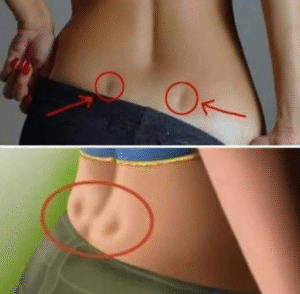
🌀 The Mystery of the Two Holes in Your Lower Back: What They Really Mean
If you’ve ever noticed two small indentations on your lower back—right above the buttocks—you’re not alone. These dimples, often referred to as Venus dimples in women and Apollo dimples in men, have sparked curiosity, admiration, and even myths. But what do they actually mean? Are they a sign of health, beauty, or something deeper?
Let’s dive into the science, symbolism, and cultural fascination behind these intriguing features.
📍 What Are These “Holes” Exactly?
These dimples are medically known as sacral dimples or dorsal dimples, located where the sacrum meets the pelvis. They’re formed by ligament attachments between the skin and the posterior superior iliac spine (PSIS)—a bony landmark on the pelvis.
- No muscle involved: These dimples aren’t formed by exercise. They’re anatomical features based on bone structure and ligament placement.
- Genetic trait: Their presence is largely hereditary. If your parents have them, you’re more likely to inherit them.
💪 What They Say About Your Body
While they’re not a medical diagnosis, Venus and Apollo dimples are often associated with certain physical traits:
1. Lower Body Fat
These dimples are more visible in individuals with low body fat percentages, especially around the waist and lower back. That’s why they’re often seen as a sign of fitness or athleticism.
2. Good Circulation
Some believe these dimples are linked to better blood flow and cardiovascular health, though scientific evidence is limited. Anecdotally, people with these features report fewer issues with circulation.
3. Symmetry and Beauty
The human brain is wired to find symmetry attractive, and these dimples—being perfectly aligned—are often seen as a mark of physical beauty. In fact, they’re named after Venus, the Roman goddess of love and beauty.
🧠 Myth vs. Reality
There’s a lot of folklore surrounding these dimples. Some say:
- “If you have them, you’re more likely to be sexually responsive.”
- “They’re a sign of divine beauty.”
- “They mean you’re spiritually gifted.”
While these claims are more poetic than scientific, they reflect how deeply these features are woven into cultural narratives.
🧬 Can You Develop Them?
Here’s the truth: you can’t “get” Venus dimples through exercise. Since they’re tied to bone structure and ligament placement, no amount of planking or deadlifting will create them if you weren’t born with the anatomical setup.
However, if you do have them, you can make them more visible by:
- Reducing body fat through cardio and clean eating.
- Strengthening your core and lower back to enhance muscle tone.
- Staying hydrated, which improves skin elasticity.
🌍 Cultural Significance
Across cultures, these dimples have been admired and even fetishized:
- In Western fashion, they’re often highlighted in backless dresses or swimsuits.
- In Eastern traditions, they’re sometimes seen as energy points or signs of balance.
- In modern fitness culture, they’re considered a badge of health and discipline.
🧘♀️ Psychological Impact
People who discover they have Venus or Apollo dimples often feel a boost in self-esteem. It’s a unique trait—something not everyone has—and that sense of rarity can be empowering.
- Body positivity: Embracing these dimples can be part of a larger journey toward loving your body.
- Confidence: Some people flaunt them proudly, while others keep them as a quiet personal charm.
🩺 Are They Ever a Cause for Concern?
In most cases, these dimples are completely harmless. However, sacral dimples in infants can sometimes be associated with spinal abnormalities like spina bifida occulta. If the dimples are unusually deep, asymmetrical, or accompanied by other symptoms, medical evaluation may be necessary.
For adults, though, they’re typically just a benign anatomical feature.
🔍 The Science Behind the Beauty
Let’s break down the anatomy:
- Posterior Superior Iliac Spine (PSIS): This is the bony landmark where the dimples form.
- Ligament attachments: These create the indentations by pulling the skin inward.
- No muscle involvement: Unlike abs or glutes, these can’t be “built.”
This makes them a rare example of a purely structural aesthetic feature—one that’s not influenced by effort or lifestyle (though visibility can be).
🧭 So What Does It Mean If You Don’t Have Them?
Absolutely nothing negative.
- It doesn’t mean you’re unhealthy.
- It doesn’t mean you’re unattractive.
- It doesn’t mean you’re missing out.
Most people don’t have these dimples, and their absence is just as normal as their presence. Beauty and health come in countless forms, and Venus dimples are just one of many.
🌟 Embrace Your Backstory
Whether you have these dimples or not, your body tells a story. Venus and Apollo dimples are just one chapter—a fascinating blend of genetics, anatomy, and cultural meaning.
If you do have them, celebrate them. If you don’t, celebrate everything else that makes you unique.


